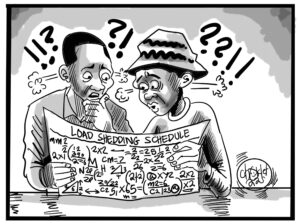Standard & Poor’s Global Ratings has downgraded Zambia’s long-term foreign and local currency sovereign credit ratings from B to B -, reflecting the country’s faster debt accumulation and higher fiscal deficits.
And S&P, the globally-renowned integrated financial services company, says the Zambian government’s future policy responses are difficult to predict due to the ongoing political tension between the PF and opposition.
In a statement issued, Friday, S&P announced that Zambia’s long-term foreign and local currency sovereign credit ratings had been downgraded to B – from B, reflecting the country’s faster debt accumulation and higher fiscal deficits than earlier projected.
It, however, maintained its stable outlook for the country’s economy.
“The Zambian government has revised its fiscal data and we now expect higher deficits and faster debt accumulation than we had previously forecast. We are, therefore, lowering our long-term foreign and local currency sovereign credit ratings on Zambia to B- from B and affirming the B short-term ratings. The outlook is stable,” S&P stated.
“The downgrade reflects Zambia’s higher fiscal deficits and faster debt accumulation than we had previously expected. The Zambian government revised its fiscal deficits and debt burden in June 2018 to account for higher capital expenditures than it had previously recorded. The corrections resulted in a materially weaker 2017 general government deficit of 7.6 per cent of GDP, up from our previous estimate of 6.0 per cent. We have also increased our projections for future deficits by a similar magnitude, resulting in our forecast net government debt burden rising above 60 per cent of GDP.”
The agency warned that it could further dampen Zambia’s credit worthiness soon if the country’s fiscal deficit position continues to deteriorate.
“We could lower the ratings over the next year if: the previously destabilising factors re-emerge and further weaken the government’s fiscal position, for example, significant currency depreciation; economic growth slowed because of confidence-related factors; or copper prices were to materially fall,” it warned.
“We do not expect to raise the ratings over the next year. However, should Zambia’s external imbalances reduce materially faster than we expect, in tandem with faster economic growth than we currently forecast (which could lead us to raise our GDP per capita trend growth forecast), we could consider a positive rating action.”
S&P explained that Zambia’s public external debt, which has risen to over US $9.3 billion this year, makes the country vulnerable owing to continued dependence on copper.
“A number of structural factors constrain the ratings on Zambia. These include its low wealth levels, high fiscal deficits, and debt burden. Despite relatively modest levels of external debt, we view external risks as high, due to the country’s dependence on copper exports to generate current account receipts. Our external analysis is also hampered by the lack of comprehensive external data,” S&P narrated.
It also revealed that government is not likely to achieve its fiscal consolidation target for this year.
According to the 2018 national budget, government projected to limit the overall fiscal deficit to 6.1 per cent of GDP on a cash basis.
“Mid-year 2018 expenditures already surpass the government’s half-year target. In our view, the results of fiscal consolidation measures will likely be realised only in the next few years. As a result, we estimate the fiscal deficit in 2018 will remain around 7.6 per cent of GDP and only decline to 5.5 per cent by 2021,” it stated.
“The Zambian government revised its 2017 fiscal deficits and debt burden on June 14, 2018, to take into account capital expenditures that took place in 2017 but were not properly recorded in its public finance management system. These revisions resulted in a fiscal deficit for 2017 of 7.6 per cent of GDP, compared with our previous estimate of 6.0 per cent. We now forecast higher fiscal deficits through 2021. We see the country’s shortfall of basic services to the population and infrastructure likely creating lasting spending pressures.”
And S&P disclosed that the Zambian government’s future policy responses are difficult to predict due to the ongoing political tension between the PF and opposition.
“Zambia has a relatively stable political environment for the region, but, in our view, future policy responses are difficult to predict because of the highly-polarised political landscape, with tensions both within the governing Patriotic Front and with opposition parties,” stated S&P.



















